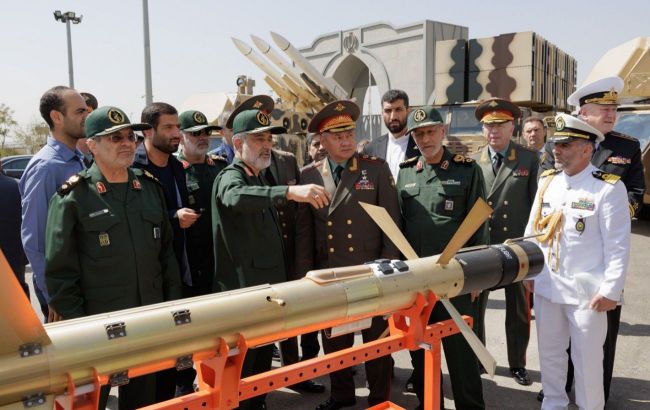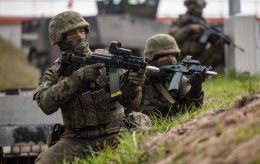Ababil and Fateh-110: Potential transfer of Iranian ballistic missiles to Russia, implications for Ukraine's security
 Iran showcased missile developments to Russian Defense Minister Sergei Shoigu in September (Photo: Getty Images)
Iran showcased missile developments to Russian Defense Minister Sergei Shoigu in September (Photo: Getty Images)
Western partners of Ukraine are once again concerned about the potential supply of Iranian ballistic missiles to Russia. According to the White House, Tehran is reportedly considering options to transfer Ababil and Fateh-110 missiles.
For more details on these missiles, their differences from Russian ones, and whether our air defense system is prepared for new challenges, check out the material by RBC-Ukraine.
The material draws upon: statements from White House National Security Council spokesperson John Kirby, sources from The Wall Street Journal and the Ukrainian specialized portal Defense Express, comments from Andrii Cherniak, a representative of the Defense Intellifence of the Ministry of Defense of Ukraine, and expert Valerii Romanenko.
Is Iran ready to transfer ballistic missiles? US warns, Ukraine monitors
The Russian Federation has long been interested in Iranian ballistic technology due to the high intensity of missile strikes. Last week, discussions resurfaced in the US regarding the potential transfer of missiles for use in the conflict in Ukraine.
According to a White House National Security Council spokesperson, John Kirby, against the backdrop of Russia's increasing isolation, Russia is intensifying military cooperation with Iran. This, in turn, poses threats to Ukraine and the international community as a whole. Tehran has already supplied combat drones, guided bombs, and artillery shells. Now, it might be preparing to transfer short-range ballistic missiles, Ababil and Fateh-110, after showcasing them to Russian Defense Minister Sergei Shoigu in September.
"We are therefore concerned that Iran is considering providing Russia with ballistic missiles now for use in Ukraine," emphasized Kirby.
Meanwhile, Moscow is fostering partnerships in complex military technologies such as missiles, electronics, air defense, and satellite data collection. Kirby cites the planned purchase of Su-35 fighters as an example of technology transfer. Iran is also interested in acquiring helicopters, radars, and training aircraft. According to Washington's estimates, this involves billions of dollars in equipment to bolster Iran's military capabilities.
 Photo: Demonstration of Iranian missiles for the Russian military delegation (mil.ru)
Photo: Demonstration of Iranian missiles for the Russian military delegation (mil.ru)
Russia has been attempting to acquire Iranian weaponry since 2022, specifically Fateh-110 and Zolfagar ballistic missiles. The aggressive nation persistently pursues this direction, making serious diplomatic efforts that, as of yet, have not succeeded, according to Andrii Cherniak, a representative of Ukrainian military intelligence.
"According to the Defense Intelligence of the Ministry of Defense of Ukraine, as of now, there have been no recorded deliveries of cruise missiles from Iran to Russia. According to our data, there are currently no corresponding decisions or agreements between Moscow and Tehran," he noted in a comment to RBC-Ukraine.
Assessing Iran's readiness to transfer ballistic missiles is difficult. Recently, Moscow accepted several Iranian military transport planes, including Il-76, which are actively used to deliver Shahed drones. There are no real signals of missile deliveries, explains aviation and missile armaments expert Valerii Romanenko.
"While threats are always present, if Iran has something, and Russia can offer something in return. Currently, Iranians are undergoing training on Yak-130 training aircraft, and in Komsomolsk-on-Amur (a city in Russia known for the manufacturing of Su-series aircraft - Ed.), 24 Su-35 fighters, rejected by Egypt and intended for sale to Iran by the Russians, are already behind the fence. Tehran is not wealthy in currency; Iranians pay reluctantly, supplying drones and munitions to Russia. Perhaps they'll manage without missiles, but, of course, it's necessary to monitor and study remnants," he shared in a conversation with the news agency.
The Russian side officially refrains from commenting on the ballistic issue. Meanwhile, other indications of strengthening ties exist. According to The Wall Street Journal, the Wagner Group, a paramilitary organization, intends to transfer the Pantsir-S1 air defense system to Lebanese Hezbollah, supported by Iran. The deal is yet to be finalized, and the US is monitoring whether Hezbollah or Tehran will ultimately receive it.
Ababil - a new development. What is known about it?
Leading Iranian defense organizations showcased their latest advancements in military technology at the Army-2023 forum in Russia this year. The central presentation was the ballistic missile Ababil, along with a container launch unit for 8 missiles.
According to Iranian media, the missile bears a visual similarity to the Zohair (Raad-500) developed by the Aerospace Forces of the Islamic Revolutionary Guard Corps. Some technical specifications have been disclosed:
- Length - 3.7 meters
- Total weight - 240 kg
- Warhead weight - 45 kg
- Flight range - 86 km
Depending on the modification, various targeting systems are implemented. The standard Ababil employs an inertial system for shooting by coordinates, while the Ababil OP incorporates electro-optical guidance. No other information about its parameters is available in the public domain; the only accessible image is a model exhibited at Army-2023.
 Photo: Model of the Ababil ballistic missile (irna.ir)
Photo: Model of the Ababil ballistic missile (irna.ir)
If Russia acquires Ababil ballistic missiles, it could use them against Ukrainian forces on the front, freeing up a certain amount of S-300 missiles that are currently targeting the cities near the front line, write analysts at Defense Express. This poses a significant challenge to our air defense considering the limited number of complexes capable of intercepting ballistic missiles.
Considering the missile's 86 km firing range, practically the same cities near the front line of Ukraine, which are currently under attack, would be under threat, specifies expert Valerii Romanenko. According to him, it's not certain if the warhead indeed carries 45 kg of explosives because sometimes they manufacture the casing thicker to increase the blast radius through shrapnel.
"Ababil is more of a tactical missile, roughly corresponding in parameters to systems like Tochka-U, Smerch, or Uragan. To say that they represent a new danger for us is not entirely accurate," he added.
Fateh-110 - Combat-tested missile in Syria
There's significantly more information available about the Fateh-110 ballistic missile (which means "conqueror" in Persian - Ed.). Serial production began in the early 2000s, and these missiles were used in the Syrian war. There is evidence of deliveries to the terrorist organization Hezbollah in Lebanon. The third generation, developed for the Syrian conflict, was designated as the M-600. According to Israeli intelligence, hundreds of units were produced, making Fateh-110 one of the most mass-produced in its class.
"Regarding Fateh-110, for the most mass-produced missile (third generation), the range is not high, up to 300 km. So, even with great desire, it won't reach Kyiv. However, it has a much larger warhead, reaching 650 kg," explained Valerii Romanenko.
Main characteristics:
- Class - surface-to-surface
- Launch speed - 3 Mach (3704 km/h)
- Speed at the moment of impact - 4 Mach (up to 5000 km/h)
- Length - 8.86 meters
- Diameter - 0.61 meters
- Total mass - 3,450 kg
- Warhead mass - 400-650 kg depending on the generation
- Range - up to 300 km (up to 400 km declared for the fourth generation)
- Platform - 6x6 truck, only one missile on the launcher In terms of its parameters, Fateh-110 has significantly greater destructive power than Russian Tochka-U, S-300, and Iskander missiles.

Photo: Fateh-110 missile has significantly greater destructive power than its Russian "classmates" (ypa.ir)
"Furthermore, Iranians also possess the Zolfaghar ("sword of the prophet' in Persian - Ed.). This missile has a range of up to 700 km, but the warhead's weight, according to different data, has been reduced to 500 or even 300 kg," noted the expert.
As reported by The Washington Post, back in October, Iran was preparing to transfer the first batch of Fateh-110 and Zolfaghar missiles to Russia, along with Mohajer-6 and Shahed-136 strike drones. It's believed that Zolfaghar (and perhaps other Fateh-110 family missiles) utilize commercial GNSS systems for increased accuracy. Defense Express analysts believe that Moscow is particularly interested in their precision and will likely use them to terrorize major Ukrainian cities.
Iranian missiles significantly differ in their design from what the Russian military-industrial complex produces: different dimensions, engines, and generally smaller warheads. They are guided by GPS and GLONASS satellite systems, susceptible to electronic warfare means, and are overall simpler than Iskanders.
"Russian Iskanders can deploy countermeasures and maneuver during the terminal phase of the flight, making it more challenging to eliminate them in the air. Iranian missiles cannot maneuver. However, being ballistic, they can only effectively be intercepted by anti-missile complexes like Patriot and SAMP-T," emphasized Romanenko.
Nevertheless, the specifications of Iranian missiles, like other armaments, might raise doubts. The claimed range of the same Shahed strike drone is supposedly 2000 km, yet today, its confirmed target range is a maximum of 1200 km.
"Arms manufacturers often err by using data obtained under ideal conditions in their product advertisements. Iran is certainly no exception. Therefore, it's essential to compare missile characteristics with conclusions from Western experts and consider what they are based on: real satellite-recorded indicators or promotional information," added the expert.
How to defend against Iranian ballistic missiles
Since around spring, Russia has been increasing missile production. According to Ukrainian intelligence, there are approximately 870 high-precision missiles in stock capable of hitting targets beyond 350 km. Among them are approximately 80 Kinzhals and around 290 Iskanders, some of which are in ballistic modification.
Regarding production rates, Russia is producing approximately 30 Iskander-M missiles monthly and several Kinzhals (according to October's data, four units). Hence, any potential supply from Iran potentially increases ballistic threats for Ukraine.
 Photo: Systems like Patriot will be most effective against Iranian ballistic missiles (Getty Images)
Photo: Systems like Patriot will be most effective against Iranian ballistic missiles (Getty Images)
The main issue lies in the fact that these are ballistic missiles, flying nearly vertically and at immense speeds in their terminal phase. Under such circumstances, systems like NASAMS, IRIS-T from Western partners, or the Ukrainian S-300 can't effectively counter them. The principle behind these anti-aircraft missiles isn't direct impact but detonation near the interception target. In such a scenario, a ballistic missile might incur partial damage, but due to its heavy warhead, it would achieve the required impact, even if it deviates by tens of meters from the target.
Hence, effectively neutralizing both Russian and Iranian missiles can only be achieved by systems like SAMP-T and Patriot, operating on the hit-to-kill principle.
"These systems, like Patriot… and SAMP-T, are the only ones capable of this. We're expecting them from France and Italy. Therefore, increasing the number of anti-ballistic systems is a crucial issue for Ukraine," said recently the Air Force spokesman Yurii Ihnat.
Currently, Ukraine has deployed two Patriot anti-aircraft missile systems and one SAMP-T. Recently, German Ambassador Martin Jaeger announced Berlin's transfer of another Patriot this winter. If Ukraine receives a second SAMP-T in the coming months, there will be a total of five anti-ballistic systems. Ukrainian personnel are currently undergoing training for the third Patriot in Germany, mentions Valerii Romanenko.
"Even if we have five anti-aircraft missile systems by the start of the next year, we will still only be able to protect four cities. One Patriot for Kyiv isn't sufficient since the capital spans both banks of the Dnipro, its area surpassing the coverage of a single system. Therefore, Kyiv needs two, while smaller cities require only one anti-missile system. Currently, only Kyiv and perhaps one other city are reliably covered against ballistic threats," summarized the expert.
***
In October 2023, the embargo on Iran for the sale of missile armaments, imposed according to the UN Security Council resolution, was lifted. The end of the ballistic ban was good news for Russia as there are fewer factors restraining their partner.
That same month, the US and its allies reached an agreement to prevent any transfer of Iranian ballistic technologies. It's challenging to determine the effectiveness of these restrictions or whether Tehran would risk escalation. Currently, nothing is known about deliveries to Russia, but this possibility should not be ignored.

